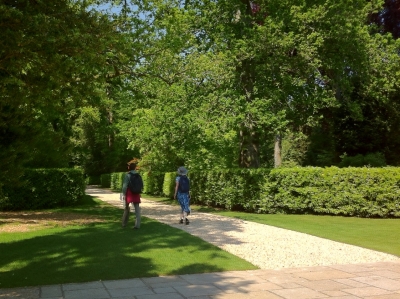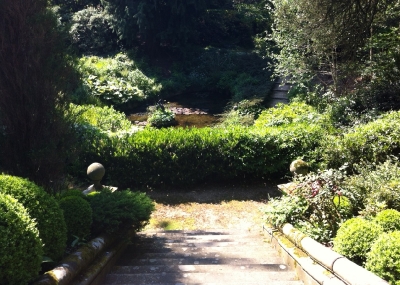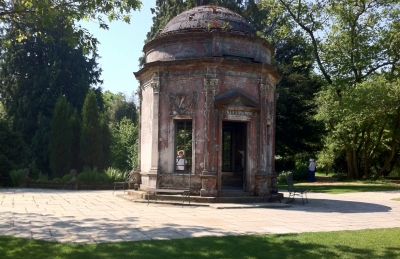To search the RPR site click here
Larmer Gardens Guide
As one of the public attractions on his estate, Pitt-Rivers established some pleasure grounds, the Larmer Tree Gardens. He published an (undated, but must have been post 1894) guide to them, which was printed in a short booklet with a guide to King John's House and the Museum at Farnham.
Going to the Larmer Gardens or to the Museum or King John's House was a way for the public to meet General Pitt-Rivers. As Bowden relates:
'... as Frank Adams recalled: 'Now if you should happen to pick up a half dozen coins which is quite an easy thing to do after these excavations ... proudly take them to Larmer on a Sunday afternoon; if you see him by himself strolling across the lawn and show him these coins, it would please him immensely that would. He thought you had an interest in archaeology.' [1991: 151-2]
The photographs are from a visit made to Larmer Tree Gardens on 27 May 2012, by Friends of the Pitt Rivers Museum and members of the Rethinking Pitt-Rivers project team and M.St Students from the Pitt Rivers Museum. We are very grateful to some of them for providing copies of their images to the website.
THE LARMER GROUNDS
The Larmer Grounds are the property of General Pitt-Rivers, of Rushmore, who, whilst retaining all rights of ownership and privacy, has laid them out as pleasure grounds, for the recreation of the people in the neighbouring towns and villages. They were commenced in 1880, and have been improved from time to time. The Temple was erected in 1880, the Band-Stand in 1886, the half-timbered cottage for the Caretaker in 1881. The bronze statue of "The hunter of early days" was put up in 1883. This beautiful little work was done by the celebrated sculptor, Mr Boehm, and represents very faithfully an ancient British hunter mounted on his small horse, and watching his prey with his spear in his hand. [1] The dell was originally dug for brick-earth, and has been planted with shrubs and trees. Walks and a lawn have been made in the surrounding oak woods. The bronze storks in the pond are Japanese.
The Larmer Tree is traditionally the spot where King John used to meet with his huntsmen when stopping at his hunting box, now called King John's House, in Tollard Royal. Tollard derives the name Royal from the fact that King John, in the right of Isabella his wife, held a knight's fee there. The Chase was originally a Royal hunting-ground, and belonged to the King.
The etymology of the word "Larmer" has been much disputed. It was originally spelt Lavermere, which has been corrupted and abbreviated into Larmer in quite recent times. The termination mere is undoubtedly boundary, like the town of Mere. The spot is still the boundary of two counties and three parishes. But the first two syllables, Laver, or Lauer, as it is sometimes spelt in old maps, has been questioned. It was no doubt a boundary mark in the Chase, and was probably named from some shrub or plant that grew in abundance on the spot. Some have supposed it to be derived from the Anglo-Saxon Laur (Latin, Laurus), a laurel or bay tree. But the best derivation for it appears to be that suggested by the Rev. J.H. Ward, Rector of Gussage St. Michael, Anglo-Saxon Laefer, a bulrush. Barnes, in his "Glossary of the Dorset Dialect," says that the term Levers, or Lever, is still used for the great yellow flag or its leaves (iris). It is retained in the word "laefer bottomed chair," a basket or rush-bottomed chair. This plant is still abundant in the woods and hedgerows. In an Anglo-Saxon charter of King Eadwig, 10th century, Mr Ward has found that in defining a boundary in this neighbourhood mention is made of Lafresmere, and immediately afterwards of the Mearc-treowe, or boundary tree, which probably refers to this place, and if so, it is the earliest mention of it on record. Rushmore was originally spelt Rushmere, and was no doubt like Lavermere, a rush boundary. Bridmore, close by, was spelt Bridmere or Britmere, and like Britford near Salisbury, probably referred to the boundary of the Britons.
It seems likely then, that these meres may have been the boundaries that separated the Saxons from the West Welsh, which, as Green in his "Making of England" has shown, lay somewhere in this neighbourhood for more than 100 years about the time of the 6th century. The old tree was originally a wych elm, a fragment of the rind of which was standing until it was blown down in the winter of 1894. [2] An oak tree had been planted in the centre of the rind after the centre had decayed. This has grown up, and now remains the only representative of the Larmer Tree. Under the wych elm the Chase Courts used to be held for the settlement of all matters relating to the Chase. The members of the Court afterwards dined together at King John's House. A public hunt, like the Epping hunt, used to be held here during the time that the Court was sitting, some time in September, when a stag was turned out and hunted. This was discontinued by Lord Rivers in 1789.
The costume of the Caretaker is a survival of the dress worn by the Chase keepers, a full length portrait of one of whom, by Romney, is preserved in Rushmore House.[3]
From the Temple on the lawn, Rushmore is seen through a gap in the wood to the north-east, over a wooded valley in the Park. To the south-east, the white cliffs of the Needles, Isle of Wight, thirty miles distant, can be seen on a clear day, through the arched vista in the paling which bounds the garden on the east side. In addition to the general lawn, there are six quarters hedged off by laurels and shrubs, and intended for picnic parties. These may be engaged beforehand, if they happen to be available at the time, by writing to the Caretaker, Larmer Grounds, Tollard Royal, Salisbury. The quarters are named after animals as follows:-- 1. Owl's Quarter; 2 Cat's Quarter; 3. Yak's Quarter; 4. Stag's Quarter; 5. Hog's Quarter; 6. Hound's Quarter. Others are in course of preparation. Each quarter has an arbour, seats and tables. The Caretaker is directed not to reserve any quarter for a party of less than eight. When not engaged, the quarters are open to the public. The grounds are open to the public every day, gratis, Sundays included, from mid-day to dark. The gates are locked by order of General Rivers in the evening until about mid-day on the following day, for the preservation of rights. They are also locked on certain occasions during the whole day, or when General Rivers reserves the grounds for private parties. The old notice respecting trespassers, which was attached to a tree before the grounds were laid out, remains standing. All parties of more than twenty, coming to the Larmer, should write to the Caretaker beforehand to ask permission, or to the Head Gardener, Rushmore, or to General Rivers. Picnic parties wishing to have quarters reserved for them should write to the Caretaker, stating the number, and what they will require. General Rivers provides crockery, knives and forks, and other materials for picknickers gratis. The attendants will expect a slight renumeration for their trouble. Two cooking stoves with cooking utensils, methylated spirits, and other necessaries, are provided by General Rivers, but the parties must bring their own cooks. Chairs, tables and dumb-waiters are also provided. The Caretaker can provide milk, tea, coffeee, bread, butter, salt, pepper, mustard, lemons, potatoes, ginger beer, flour, fresh eggs, and some other commodities, but he should know what will be required, if possible, two days before. Meat vegetables, fruit, sauces and liquor of all kinds must be brought, if required by the visitors. No alcoholic liquor is allowed to be sold on the grounds, except on special occasions, when due provisions will be made. German skittles, bowls and swings are provided in the shrubbery. Chairs, tables, and benches in sufficient number are on the lawn and in the quarters.
The Band consists of workmen on the Rivers estate. Mr. A. Lawes, of Tollard Royal, Salisbury, is the Band-master, to whom application should be made by parties requiring the Band in the evening. The Band is paid by General Rivers every time it plays at the Larmer, except when privately engaged by parties for their evening amusements. He also provides the uniform, instruments, and instruction. Parties who require to have the Band on any day can do so from 5.30 pm till dark, on applying to the Bandmaster. The charge will be 35s. for the evening for about 16 men. [4]
The Band is also allowed to engage itself for the day in the neighbourhood on special occasions, arrangements being made with the Bandmaster, who acts in all cases under the orders of General Pitt-Rivers. Accommodation for 20 horses is provided in the stables inside the grounds, and further arrangements for tying up horses are made outside. Drivers should bring their own head collars and feeding bags. The Band plays every Sunday in the grounds, during the Summer months, from 3 p.m. to 5 p.m. The Bandmaster is the Organist in the Church and has to attend every Service.
General Rivers will alter all the arrangements at the Larmer, from time to time, at his own discretion, should it be found necessary.
The Larmer Grounds have been made the headquarters of a Bicycle Club, and is much visited by cyclists from all parts.
There has never been a single instance of drunkenness, disorder, or trouble of any kind during the seven years that the Larmer and other places have been open to the public, nor has any damage whatever been done. Arrangements are, however, made with the police to meet any difficulty, should it occur, and two policemen are present every Sunday and on other days when large numbers are expected.
General Pitt-Rivers has been in the habit of opening the grounds and the field adjoining it for races and sports some time in September, the arrangements for which are conducted by himself, with the assistance of a committee. General Rivers gives the prizes. Notice of these meetings and a programme of the sports are circulated in the neighbourhood and in the local newspapers. These meetings are intended to be a survival of the hunt which used to take place here at the same time of the year, and which was discontinued by Lord Rivers in 1789. These meetings have usually been attended by a large concourse of people.
All persons visiting the Larmer, the Museum, and King John's House, must sign their names in a book. A single name will be sufficient for large parties, stating the total number in the column provided for the purpose. It is the Caretaker's business to see that this is done.
|
|
1887 |
1888 |
1889 |
1890 |
1891 |
1892 |
1893 |
|
Larmer Grounds |
15,351 |
10,760 |
10,653 |
14,690 |
16,872 |
17,502 |
24,143 |
|
Museum, Farnham |
- |
5,706 |
6,152 |
6,673 |
7,000 |
6,548 |
7,187 |
|
King John’s House |
- |
- |
- |
- |
4,346 |
5,828 |
6,710 |
Distances from the Larmer.
The Larmer Grounds are distant:-
From the Museum at Farnham, 2 miles
From the Museum Hotel at Farnham, 1 3/4 miles
From King John's House at Tollard, by path, 1/2 mile
From the little Menagerie in Rushmore Park, by road, 2 miles
From Blandford, via Tarrant Hinton and Gunville, 9 miles
From Bournemouth, via Wimborne and Poole, 25 miles
From Cranborne, via Handley, 8 1/2 miles
From Fordingbridge, via Cranborne 15 miles
From Gillingham, via Shaftesbury, 15 miles
From Poole, via Wimborne, 20 miles
From Ringwood, via Horton, 16 1/2 miles
From Salisbury, via Woodyates and Handley, 17 miles
From Semley, via Ludwell, 9 1/2 miles
From Tisbury, via Berwick and Rushmore Park, 11 1/4 miles
From Wilton, via Toney Stratford, 16 1/2 miles
From Wimborne, via Horton, 13 miles.
Parties visiting the Larmer from Blandford, Tarrant Gunville, and Iwerne, can go along the new road in Farnham Wood, the gates of which are only locked periodically for the preservation of rights.
Telegraphic communication to all parts is established in Tollard Royal, within ten minutes of the Larmer.
Visitors coming from Tisbury and the north can go through Rushmore Park, on asking permission to do so at the Lodge gates. There is no right of way.
Notes [added by transcriber, not part of original publication]
[1] This statue in now in a private collection, according to here. It was first sculpted by Joseph Edgar Boehm (1834-1890) in 1868, and exhibited at the Royal Academy in the same year. The Victoria and Albert Museum has a plaster cast of the sculpture [1806-1892].
[2] This fragment of tree can still be seen in the small museum in the Larmer Gardens in 2012.
[3] This portrait is listed in Pitt-Rivers' art catalogue on page 48, and shows Elias Bailey, last Chase-Keeper. See the last image on this page.
[4] Roughly £155 in 2012 according to here, based on purchasing power.
Transcribed by AP May 2012.

![Peacock at Larmer Gardens, May 2012 [Photo by R. McGoff]](../../component/joomgallery/peacock_20120528_1429753271-view=image&format=raw&type=img&id=1077&Itemid=41.jpg)



![Temple and Indian house, Larmer Gardens, May 2012 [R. McGoff]](../../component/joomgallery/larmer_houses_20120528_1531417710-view=image&format=raw&type=img&id=1078&Itemid=41.jpg)
![Lower Indian House, Larmer Gardens [Photo Linda Teasdale]](../../component/joomgallery/lower_indian_house_20120529_1713233401-view=image&format=raw&type=img&id=1080&Itemid=41.jpg)
![Larmer Temple from pool [Photo Linda Teasdale]](../../component/joomgallery/larmer_temple_20120529_1738539686-view=image&format=raw&type=img&id=1079&Itemid=41.jpg)
![Theatre, Larmer Gardens, May 2012 [Photo by H. Davison]](../../component/joomgallery/larmer_6_20120530_1252553541-view=image&format=raw&type=img&id=1102&Itemid=41.jpg)



